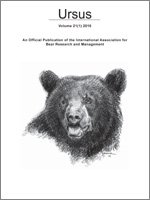The Greater Yellowstone Ecosystem (GYE) supports the southernmost of the 2 largest remaining grizzly bear (Ursus arctos) populations in the contiguous United States. Since the mid-1980s, this population has increased in numbers and expanded in range. However, concerns for its long-term genetic health remain because of its presumed continued isolation. To test the power of genetic methods for detecting immigrants, we generated 16-locus microsatellite genotypes for 424 individual grizzly bears sampled in the GYE during 1983–2007. Genotyping success was high (90%) and varied by sample type, with poorest success (40%) for hair collected from mortalities found ≥1 day after death. Years of storage did not affect genotyping success. Observed heterozygosity was 0.60, with a mean of 5.2 alleles/marker. We used factorial correspondence analysis (Program GENETIX) and Bayesian clustering (Program STRUCTURE) to compare 424 GYE genotypes with 601 existing genotypes from grizzly bears sampled in the Northern Continental Divide Ecosystem (NCDE) (FST = 0.096 between GYE and NCDE). These methods correctly classified all sampled individuals to their population of origin, providing no evidence of natural movement between the GYE and NCDE. Analysis of 500 simulated first-generation crosses suggested that over 95% of such bears would also be detectable using our 16-locus data set. Our approach provides a practical method for detecting immigration in the GYE grizzly population. We discuss estimates for the proportion of the GYE population sampled and prospects for natural immigration into the GYE.
How to translate text using browser tools
1 January 2010
Genetic analysis of individual origins supports isolation of grizzly bears in the Greater Yellowstone Ecosystem
Mark A. Haroldson,
Charles C. Schwartz,
Katherine C. Kendall,
Kerry A. Gunther,
David S. Moody,
Kevin Frey,
David Paetkau
ACCESS THE FULL ARTICLE

Ursus
Vol. 21 • No. 1
January 2010
Vol. 21 • No. 1
January 2010
Bayesian clustering
DNA
factorial correspondence
grizzly bear
immigration
Northern Continental Divide
Ursus arctos




